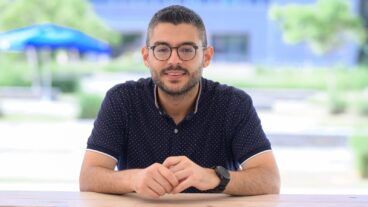If you’ve ever tried to tune into one conversation and tune out others in the din of a crowded room, you know it can be challenging – but definitely doable for most of us. There’s even a name for the phenomenon: the cocktail party effect.
But just how does our brain pull off this trick? It’s not as if we can physically focus our ears the way we can our eyes, points out Israeli cognitive neuroscientist Elana Zion Golumbic. She was part of a team whose study on selective attention is reported in the March 6 issue of the Cell Press journal Neuron.
Spread the Word
• Email this article to friends or colleagues
• Share this article on Facebook or Twitter
• Write about and link to this article on your blog
• Local relevancy? Send this article to your local press
“We have so much information coming into our senses all the time, and we are challenged to choose what to pay attention to and what to ignore,” Golumbic tells ISRAEL21c. “This is such a relevant and important aspect of our lives.”
When we look at a complicated image, we can move our eyes to different selected points, but ears don’t have a similar motor mechanism.
“All sounds in the environment come into your ears, so selection has to be done internally – it’s more a software than a hardware operation. Engineers have been trying for decades to amplify important parts and reduce background noise, and it’s quite challenging computationally. Yet human beings apparently do this well. That’s why I find it fascinating,” says Golumbic, 34.
The research provides the first clear evidence of brain locations where there is exclusive representation of attended speech while ignored conversations get filtered out.
‘Aha’ moment
Golumbic earned her undergraduate and graduate degrees at the Hebrew University of Jerusalem — her PhD adviser was Israel Prize-winning neuropsychologist Shlomo Bentin — before going to New York in 2008 to do post-doctoral work at Columbia University.
She carried out the “cocktail party effect” study at Columbia, with Dr. Charles Schroeder and colleagues from other universities.
They recorded electrical brain activity in six hospital patients who had electrodes placed on the surface of their brains in a diagnostic procedure for epilepsy. “There was no added risk to these patients, and it provided access for us that we could never otherwise get,” Golumbic explains.
The patients were shown simultaneous videos – one with a woman speaking, one with a man speaking and another with both speaking simultaneously. When asked to concentrate on the male speaker, they automatically focused their eyes on him.
Afterward, the researchers used a mathematical model to reconstruct speech patterns from the brain’s electrical activity, and matched those patterns with the original patterns coming from the ignored and attended speakers.
They found that the subjects’ brains had registered both attended and ignored speech, but not in the same regions of the brain. The ignored speech registered in the part of the brain governing sound, while the attended speech registered in regions associated with higher functioning including language.
This response became stronger over the course of the speech as brainwaves tracked and increasingly tuned into a selected sound pattern.
“I started working on this in 2009 as a postdoctoral researcher,” says Golumbic, “but there was an ‘aha’ moment the first time I saw that switching attention between two speakers causes a dramatic change in the way the brain is responding, despite the fact that the sensory input to the ears was identical. To see it manifested in the brain was what we were looking for, and it was very dramatic.”
The findings could have important implications for individuals for whom the cocktail party effect does not work well – for example, people with attention deficit hyperactivity disorder and autism, as well as the elderly.
“The ability to focus on and understand one talker in a noisy social environment is a critical social-cognitive capacity,” the researchers stated.
Golumbic has been studying the phenomenon further with schizophrenic patients in New York, and in the fall will continue her research as part of her I-CORE Israeli Centers of Research Excellence appointment to Bar-Ilan University’s Gonda Multidisciplinary Brain Research Center.
“I want to take this further to explore different populations,” she says. “Another area of interest is what type of environments are more conducive to selective attention and which are more difficult. Perhaps we can figure out optimal settings for paying attention. These are some of the directions I’d like to take this, moving forward.”
If you’re visiting the Bloomfield Science Museum in Jerusalem, by the way, you can experience some of Golumbic’s previous work. She was the scientific consultant for several brain-related exhibits including the current one about optical, auditory and tactile illusions.
Married to Rabbi Mishael Zion, co-director of the Bronfman Youth Fellowships, Golumbic is expecting her third child this summer. She says she is excited to be returning to Israel with her husband and two little girls. “It’s home — it’s where our family is, it’s where we feel we belong culturally.”
*Image via Shutterstock.
















